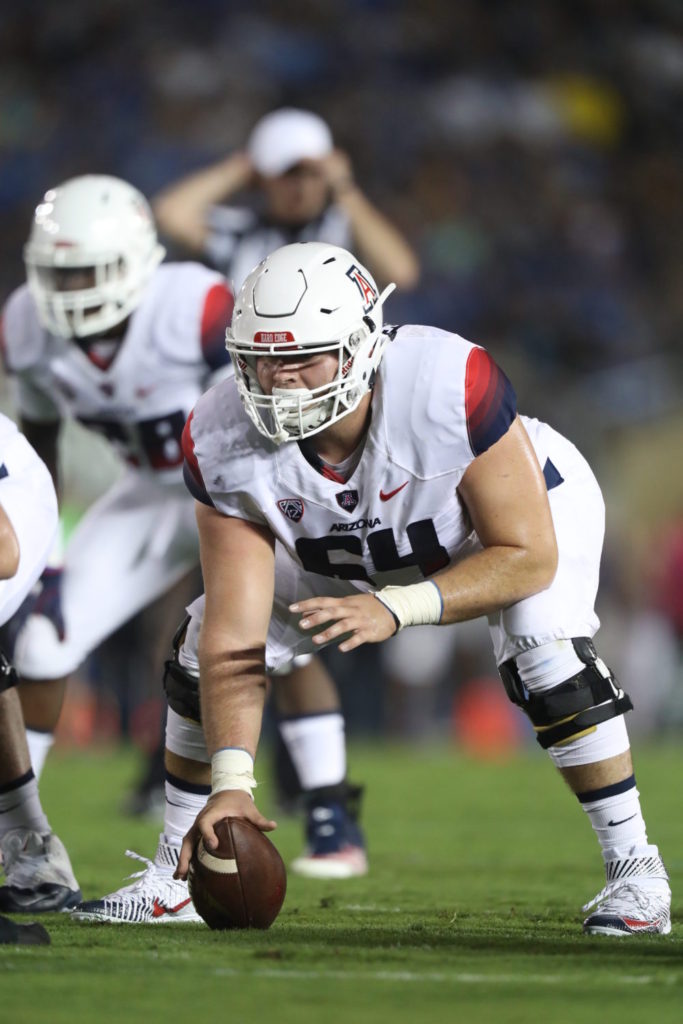Writer Tom Scanlon
Photo Credit University of Arizona
[dropcap]T[/dropcap]he first Sunday of August, University of Arizona senior Zach Hemmila went to bed, eager to begin the coming football season as the team’s starting center. He never woke up, and his death (caused by the combination of two prescription drugs, according to an autopsy) left a giant hole in the middle of UA football.
Less than a month later, Nathan Eldridge crouched down to snap the ball against Brigham Young University. The Boulder Creek High School graduate was still reeling from the loss of his friend and mentor.
“He was a huge part of this program,” Eldridge reflects. “It’s still rough not seeing him around.”
But life and football — so often intertwined for people like Eldridge — continued, and he set about honoring Hemmila with his play.
How did the redshirt freshman, who didn’t play at all last season, do in his first taste of high-pressure, Pacific-12 football? For the answer, you only have to go to Twitter and watch a video slice of the game, with Tucson’s KVOA sports reporter Ari Alexander’s excited narration: “Look at Nathan Eldridge the center — he just blocked two guys!”
Eldridge’s big block opened the way for a Nick Wilson touchdown run.
The thrill of the beginning of Eldridge’s college football career soon gave way to the daily grind. Not that he’s complaining, but that means getting up at 5:30 a.m. for 7 a.m. practices, then off to school, homework and tutoring, followed by time studying in the film room.
“It’s all work,” he says, after a recent practice.
The work is paying off, as “Big Nathan” has proved to be a rock — though at 6 feet 2 inches and 290 pounds, more like a boulder — for the Wildcats.
College has been all about tests, in class and on the field, where the Pac-12 has four of the top 20 rated defensive linemen in the country. On successive weeks, Eldridge faced them all, going up against UCLA’s Eddie Vanderdoes and the University of Washington’s fierce tandem of Elijah Qualls and Vita Vea.
“That was a really fun game, one of my favorites,” says Eldridge, whose team almost upset Washington, which later rocketed to the top five. “They both played with really good pad level.”
And then Eldridge went facemask-to-facemask with Utah’s top-rated Lowell Lotulelei, a 310-pound beast who may go in the first round of the NFL draft.
“He was a really good player; I thought I did OK against him,” Eldridge says, modestly. “He had really good fundamentals, and he played with good pad levels.”
Does it sound like he’s talking in a different language?
In high school, blocking is often about simply overpowering your opponent. With Eldridge’s size and strength (he was also a feared wrestler), that was no problem. But he would soon learn that, in Division I college football, the emphasis is on technique. All the linemen are huge, and they’re all strong. The winner of the individual challenges is the one who has the correct shoulder pad level, takes the proper angles and has his body aligned just right.
“It’s a battle with technique,” Eldridge says. “I need to do a lot better. Football-wise, I want to do so much better. Simple things, like keeping your butt down, your feet apart, hands above your eyes make a huge difference. It’s crazy, how the little things are everything.”
The biggest difference between high school and college football comes inside the helmet.
“It’s more of a mental game,” he says. “You’ve really got to know what you’re doing and your assignment. It’s specific by a matter of inches — your eyes have to be in a specific spot. It’s a game of details.”
He credits his old BC coaches with helping build the foundation that is now stressed every day.
“Shout out to all them,” Eldridge says. “They helped me get fundamentals down. Basic things are huge. Everyone thinks there’s some special technique. There’s nothing special about it.”
Now the BC football head coach, Anthony Casarella was an assistant and strength/conditioning coach when Eldridge was in high school.
“Whenever I go to Anthem,” Eldridge says, “I stop by and say hi. He’s doing a great job. Cas was always in the program. He does a great job with strength and conditioning.”
In addition to listening to people like Casarella, Eldridge has advice for high school kids around Anthem who want to go to the next level: “Be relentless. Just keep working hard and doing your best. People were telling me I was never going to be able to play D1.”
While some were advising him to transfer from BC to a high school where he could get more attention, Eldridge would have none of it.
“That’s my home!” he says. “I grew up there. I didn’t know anything else.”
Before his senior year at BC, Eldridge went to a UA summer football camp and grabbed the coaches’ attention with his combination of strength and agility. He was offered a scholarship and, after a year of learning and tough practicing, looks like he will be the anchor of the Wildcat line for the next few years.
“We are so proud of his accomplishments,” says Casarella. “It’s great to be able to watch him every Saturday.”
And, based on the way he played the likes of future pros Vea and Lotulelei, maybe in a few years we’ll be seeing Big Nate play on Sundays.







Comments by Admin